GoBGP is an open source tool developed in Go language and running on Linux systems that provides control plane functionality for the BGP protocol. Compared with Quagga/FRRouting, GoBGP has better performance and shorter convergence time, and can be applied to larger networks, such as acting as an IXP router. GoBGP can be configured via the gRPC API using multiple languages such as Python, C++, and of course the CLI. GoBGP also supports OpenConfig, and its YANG model conforms to draft-ietf-idr-bgp-model-03. Because GoBGP can easily interfere with routing manually and is more involved, it is a good tool for experimentation. In this paper, we will introduce the main features and practices of gobgp.
Background
Installation and Composition
The installation of GoBGP is very simple, just download the tar.gz file from https://github.com/osrg/gobgp/releases and unzip it. The one selected here is v2.27.0.
1
|
$ tar -xzf gobgp_2.27.0_linux_amd64.tar.gz
|
- gobgpd
- daemon for Gobgp, complete implementation of BGP protocol.
- Can interact with gobgpd via the gRPC API.
- You can also configure bgp through configuration files.
- gobgp
- Full-featured CLI.
- You can view BGP-related information and configure BGP.
- Configuration file: supports multiple formats toml/yaml/json, etc.
Support Features
- Full-featured CLI
- Multiprotocol Support
- IPv4/Pv6
- Labeled IPv4/IPv6
- Labeled IPv4/IPv6
- EVPN
- Flowspec IPv4/IPv6/L2
- Flexible Policy
- Graceful Restart
- Both restarting/helper speak role
- Route Reflector
- Route Server
- MRT Dumping
- BMP
- RPKI Validation
- FIB manipulation
- gRPC API
- Standard configuration format
Compared with Quagga/FRRouting, GoBGP has better performance and shorter convergence time, and can be applied to larger networks, such as acting as an IXP router. For more performance tests on BGP, see Comparing Open Source BGP stacks with internet routes.

Integration with Quagga/Zebra, etc
GoBGP supports only one routing protocol, BGP, but it can be integrated with Zebra to work with Quagga/FRR by way of an API to support multiple routing protocols.
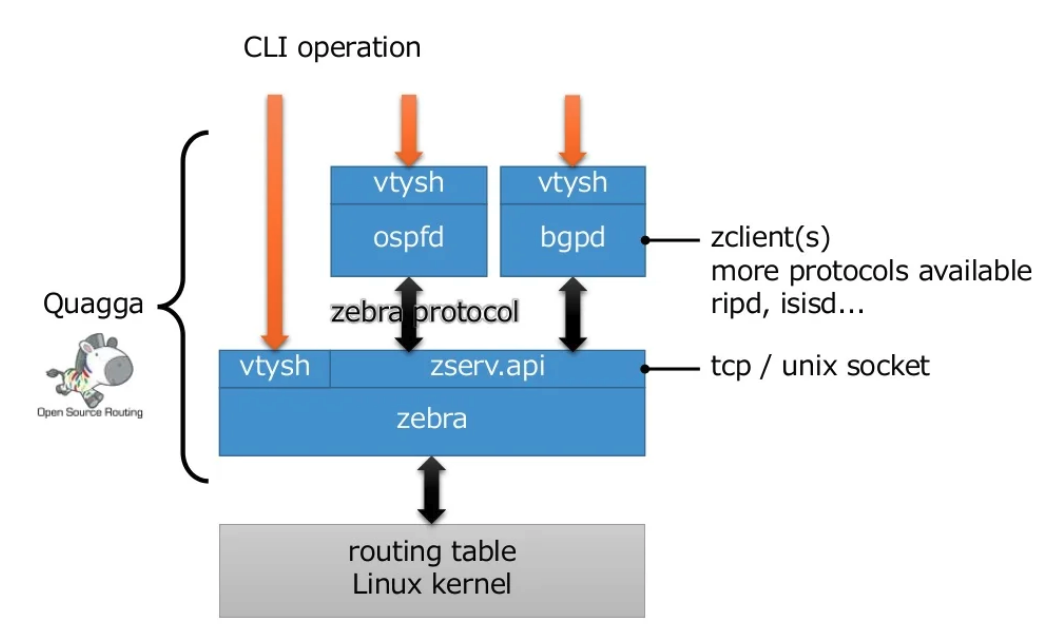
GoBGP can be integrated into the Quagga/Zebra system.
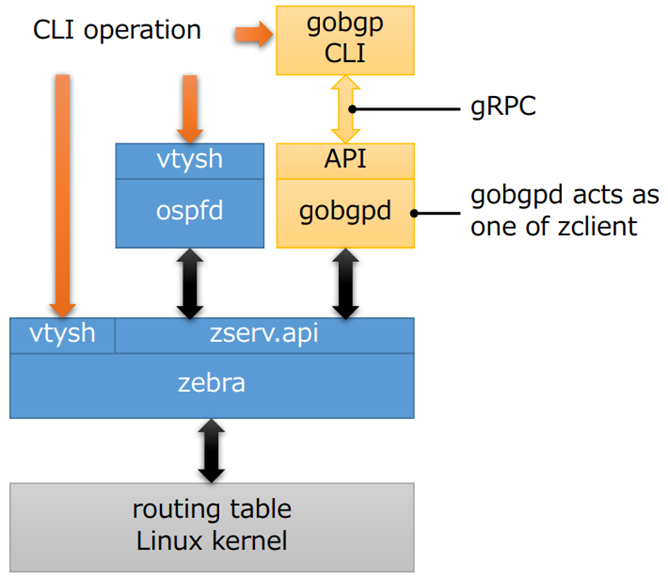
Using GoBGP
Basic operation
We can start gobgpd as a bgp server to establish a BGP connection with the switch.
Here is the network topology diagram
For example, for
1
2
3
4
5
6
7
8
9
|
[global.config]
as = 1002
router-id = "172.25.0.136"
[[neighbors]]
[neighbors.config]
peer-as = 1002
neighbor-address = "172.25.0.129"
auth-password: "xxxxx"
|
Start gobgpd.
1
2
3
4
5
6
|
/ # ./gobgpd -t yaml -f gobgpd.yaml
{"level":"info","msg":"gobgpd started","time":"2022-03-03T07:28:56Z"}
{"Topic":"Config","level":"info","msg":"Finished reading the config file","time":"2022-03-03T07:28:56Z"}
{"level":"info","msg":"Peer 172.25.0.129 is added","time":"2022-03-03T07:28:56Z"}
{"Topic":"Peer","level":"info","msg":"Add a peer configuration for:172.25.0.129","time":"2022-03-03T07:28:56Z"}
{"Key":"172.25.0.129","State":"BGP_FSM_OPENCONFIRM","Topic":"Peer","level":"info","msg":"Peer Up","time":"2022-03-03T07:29:01Z"}
|
Check the peer information via gobgp, here the Establ of the State means the connection has been established, if the State is Active then you need to check if the switch configuration is correct.
1
2
3
4
5
6
7
8
9
10
11
12
13
14
15
16
17
18
19
20
21
22
23
24
25
26
27
28
29
30
31
|
/ # ./gobgp neighbor
Peer AS Up/Down State |#Received Accepted
172.25.0.129 1002 00:01:29 Establ | 8 8
/ # ./gobgp neighbor 172.25.0.129
BGP neighbor is 172.25.0.129, remote AS 1002
BGP version 4, remote router ID 172.25.100.4
BGP state = ESTABLISHED, up for 00:01:34
BGP OutQ = 0, Flops = 0
Hold time is 90, keepalive interval is 30 seconds
Configured hold time is 90, keepalive interval is 30 seconds
Neighbor capabilities:
multiprotocol:
ipv4-unicast: advertised and received
route-refresh: advertised and received
extended-nexthop: advertised
Local: nlri: ipv4-unicast, nexthop: ipv6
4-octet-as: advertised and received
Message statistics:
Sent Rcvd
Opens: 1 1
Notifications: 0 0
Updates: 0 7
Keepalives: 4 4
Route Refresh: 0 0
Discarded: 0 0
Total: 5 12
Route statistics:
Advertised: 0
Received: 8
Accepted: 8
|
View the global table.
1
2
3
4
5
6
7
8
9
10
|
/ # ./gobgp global rib
Network Next Hop AS_PATH Age Attrs
*> 10.0.0.0/24 172.25.0.129 801 45090 45090 00:04:16 [{Origin: ?} {LocalPref: 100}]
*> 10.0.2.0/24 172.25.0.129 801 45090 45090 00:04:16 [{Origin: ?} {LocalPref: 100}]
*> 172.25.0.0/25 172.25.0.129 801 1001 00:04:16 [{Origin: i} {LocalPref: 100}]
*> 172.25.0.128/25 172.25.0.129 00:04:16 [{Origin: i} {Med: 0} {LocalPref: 100}]
*> 172.25.100.1/32 172.25.0.129 801 00:04:16 [{Origin: i} {Med: 0} {LocalPref: 100}]
*> 172.25.100.2/32 172.25.0.129 801 00:04:16 [{Origin: i} {Med: 0} {LocalPref: 100}]
*> 172.25.100.3/32 172.25.0.129 801 1001 00:04:16 [{Origin: i} {LocalPref: 100}]
*> 172.25.100.4/32 172.25.0.129 00:04:16 [{Origin: i} {Med: 0} {LocalPref: 100}]
|
Check out adjacent rib-in and rib-out.
1
2
3
4
5
6
7
8
9
10
11
12
|
/ # ./gobgp neighbor 172.25.0.129 adj-in
ID Network Next Hop AS_PATH Age Attrs
0 10.0.0.0/24 172.25.0.129 801 45090 45090 00:07:18 [{Origin: ?} {LocalPref: 100}]
0 10.0.2.0/24 172.25.0.129 801 45090 45090 00:07:18 [{Origin: ?} {LocalPref: 100}]
0 172.25.0.0/25 172.25.0.129 801 1001 00:07:18 [{Origin: i} {LocalPref: 100}]
0 172.25.0.128/25 172.25.0.129 00:07:18 [{Origin: i} {Med: 0} {LocalPref: 100}]
0 172.25.100.1/32 172.25.0.129 801 00:07:18 [{Origin: i} {Med: 0} {LocalPref: 100}]
0 172.25.100.2/32 172.25.0.129 801 00:07:18 [{Origin: i} {Med: 0} {LocalPref: 100}]
0 172.25.100.3/32 172.25.0.129 801 1001 00:07:18 [{Origin: i} {LocalPref: 100}]
0 172.25.100.4/32 172.25.0.129 00:07:18 [{Origin: i} {Med: 0} {LocalPref: 100}]
/ # ./gobgp neighbor 172.25.0.129 adj-out
Network not in table
|
The route can be declared with the following command.
1
|
gobgp global rib -a ipv4 add 192.168.1.0/24
|
Route Reflector
To ensure connectivity between iBGP peers, full connectivity relationships between IBGP peers are required . The Route Reflection mode is a mature alternative to the Full Mesh mode, which will become dramatically less efficient as the cluster size increases. The RR scheme allows a BGP Speaker (that is, a Route Reflector) to broadcast the learned route information to other BGP Peers, greatly reducing the number of BGP Peer connections.
For gobgpd, the BGP Server can be supported as a Route Reflector by modifying the configuration file by adding the RouteReflector.RouteReflectorConfig configuration as follows.
- node 172.25.0.7 as an RR node to establish a bgp peer with switch
172.25.0.1
- Node 172.25.0.6 as RR client node, establish bgp peer with RR node 172.25.0.7
- node 172.25.0.8 as RR client node, establish bgp peer with RR node 172.25.0.7
1
2
3
4
5
6
7
8
9
10
11
12
13
14
15
16
17
18
19
20
21
22
23
24
25
26
27
28
29
|
[global.config]
as = 1001
router-id = "172.25.0.7"
[[neighbors]]
[neighbors.config]
neighbor-address = "172.25.0.1"
peer-as = 1001
auth-password = "xxxxxx"
[[neighbors]]
[neighbors.config]
neighbor-address = "172.25.0.6"
peer-as = 1001
auth-password = "xxxxxx"
[neighbors.route-reflector.config]
route-reflector-client = true
route-reflector-cluster-id = "172.25.0.137"
[[neighbors]]
[neighbors.config]
neighbor-address = "172.25.0.8"
peer-as = 1001
auth-password = "xxxxxx"
[neighbors.route-reflector.config]
route-reflector-client = true
route-reflector-cluster-id = "172.25.0.137"
|
Route Server
There are some scenarios in the existing network, In order to achieve network traffic interoperability, it is usually necessary to perform full connectivity through eBGP . Full connectivity between border devices is more demanding in terms of cost consumption and device performance, and is not conducive to network topology and device expansion. Route Server is similar to IBGP full connection using route reflector , which is a device (or multiple devices) used to perform routing services, and its main function is to propagate routes to individual clients (border devices), and the routes published to clients do not modify path attributes such as AS_PATH, Nexthop, MED, etc., thus reducing the border router full connection consumption.
As shown in the figure below, an IX (Internet eXchange) contains multiple independent SPs (service providers) that want to interoperate traffic. Each SP has a border router connected to the common switching network. Each SP has its own AS number, and the BGP Router addresses range from 10.0.0.1 to 10.0.0.8.
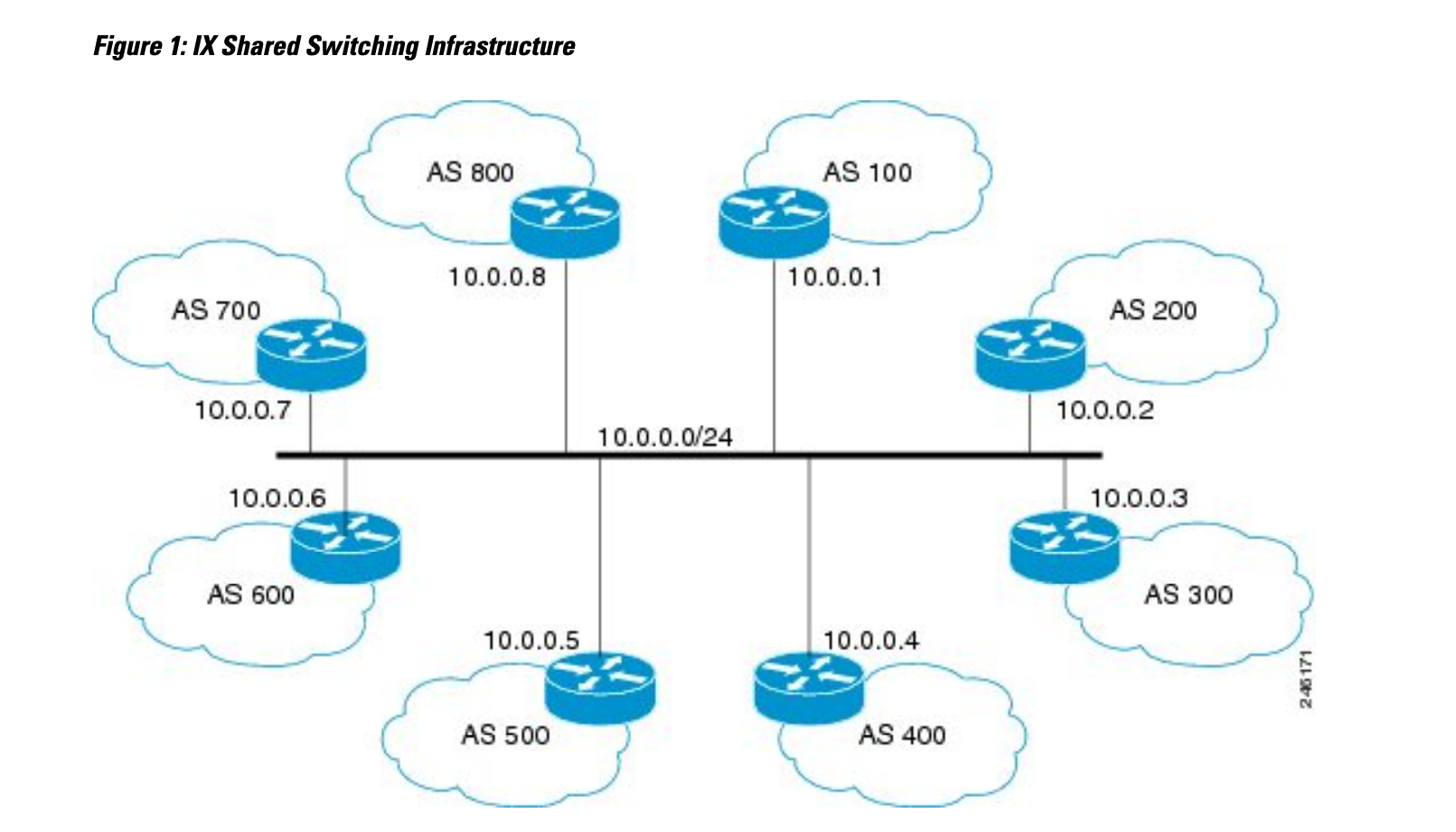
In this case, the 8 BGP Peers are required to establish a full connection. Like iBGP, this full mesh connection is more demanding in terms of cost consumption and device performance, and is not conducive to the expansion of network topology and number of devices.
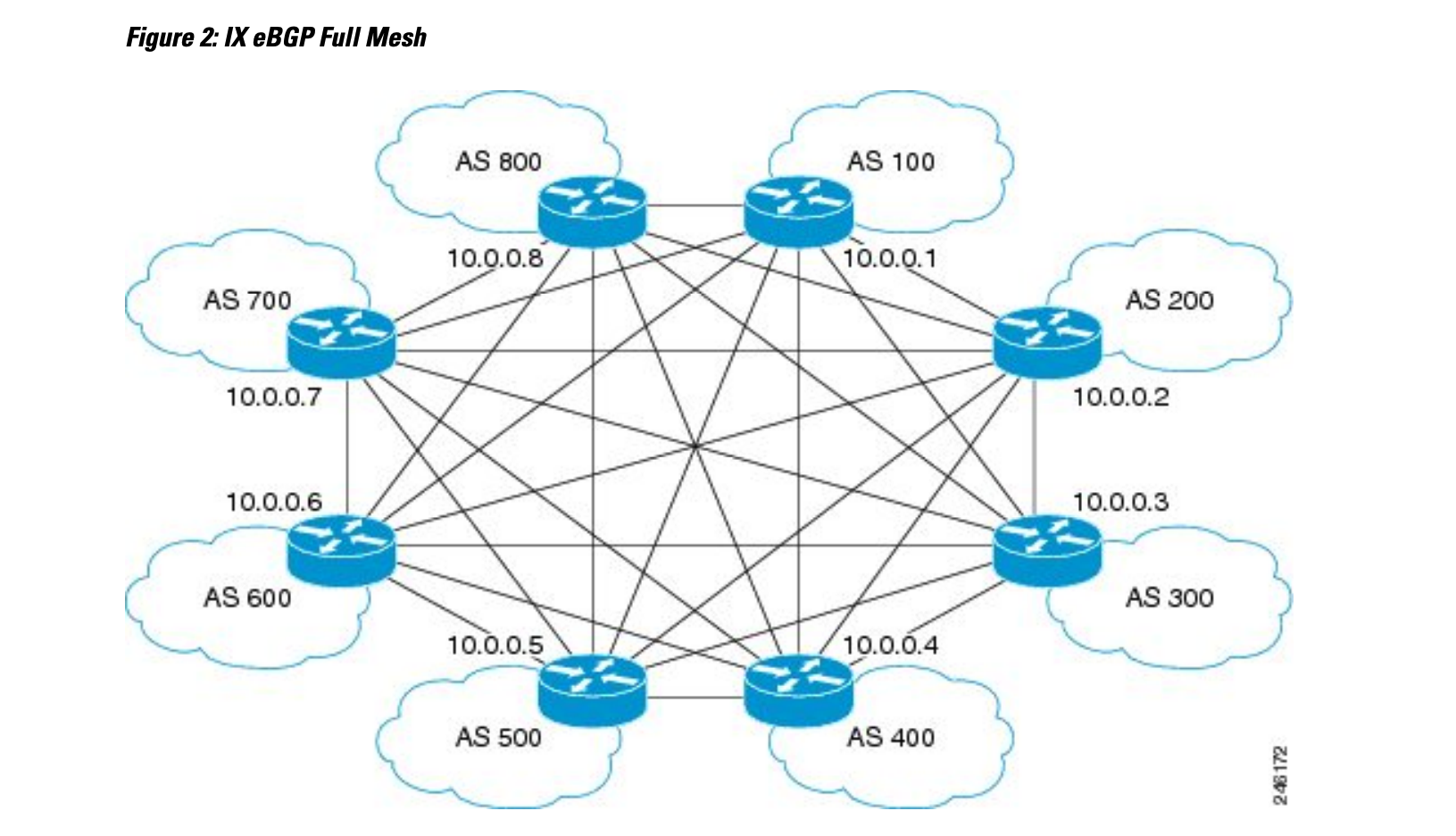
BGP Route Server can simplify SP connectivity. This is shown below.
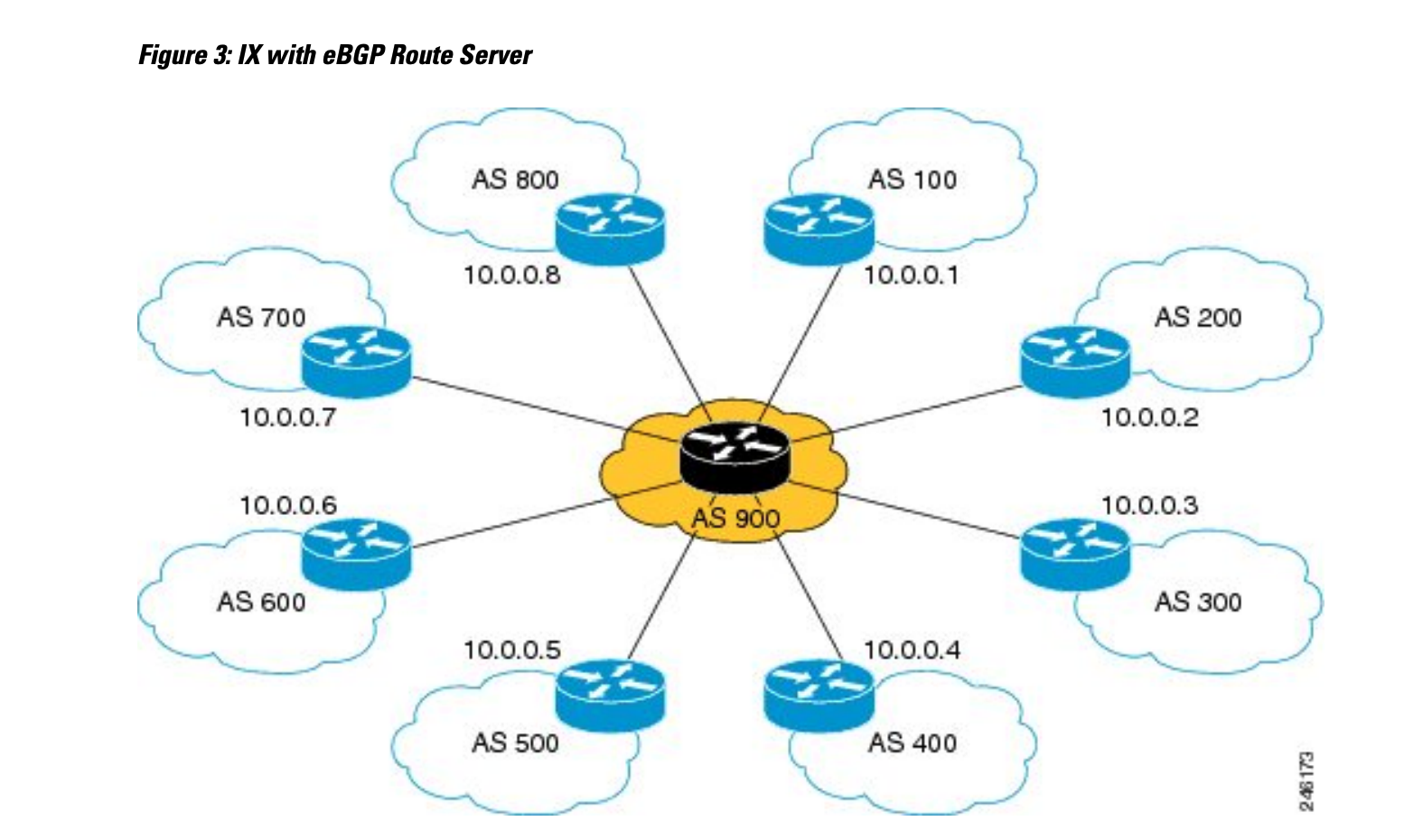
The following figure shows the transparent route propagation implemented by route server.
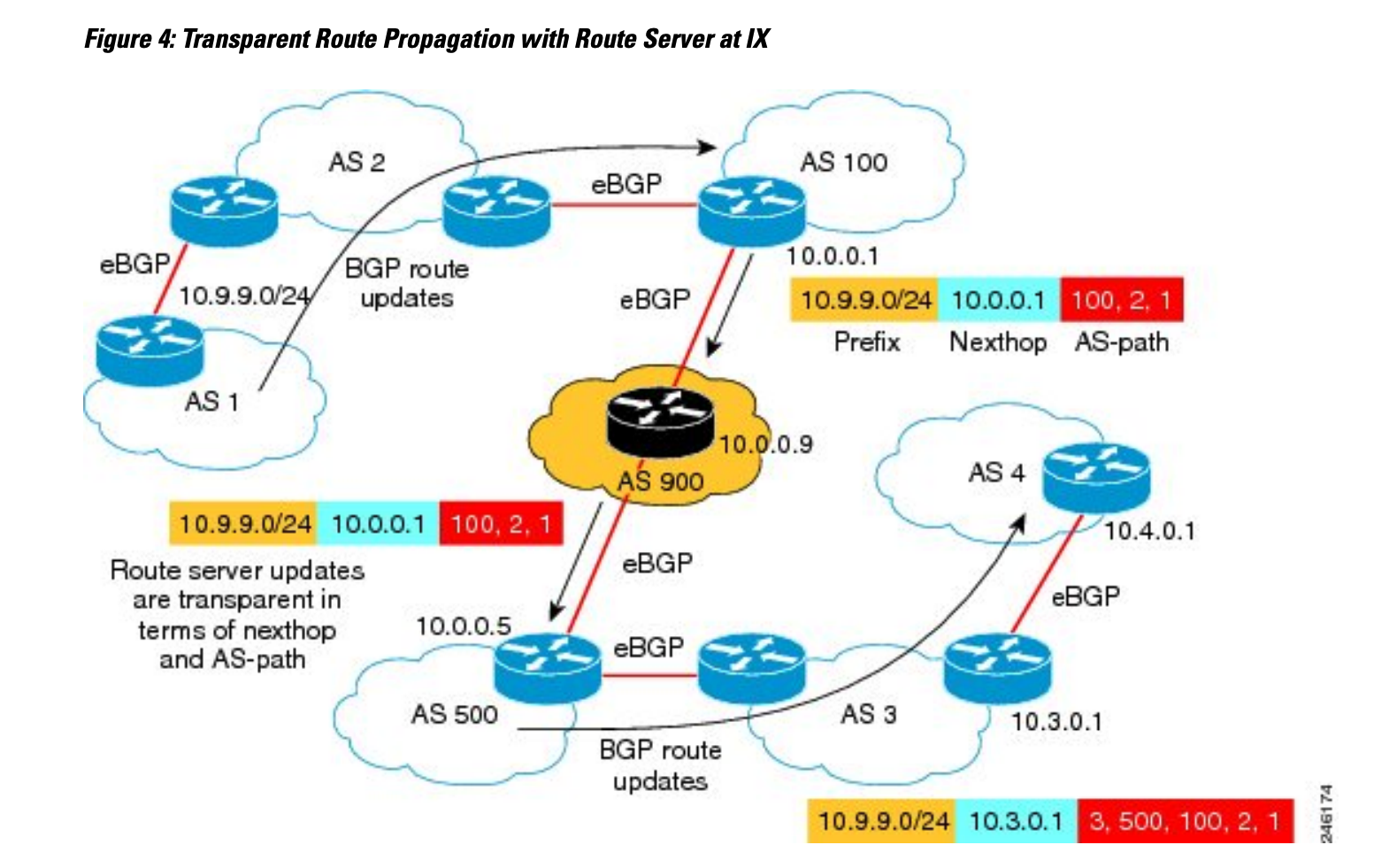
For more information about route server, you can refer to Route Server.
For GoBGP, Route Server is also supported.
1
2
3
4
5
6
7
8
9
10
11
12
13
14
15
16
17
18
19
20
21
22
23
|
[global.config]
as = 64512
router-id = "192.168.255.1"
[[neighbors]]
[neighbors.config]
neighbor-address = "10.0.255.1"
peer-as = 65001
auth-password = "hoge1"
[neighbors.transport.config]
passive-mode = true
[neighbors.route-server.config]
route-server-client = true
[[neighbors]]
[neighbors.config]
neighbor-address = "10.0.255.2"
peer-as = 65002
auth-password = "hoge2"
[neighbors.transport.config]
passive-mode = true
[neighbors.route-server.config]
route-server-client = true
|
BGP Policy
Policy is a way to control how BGP routes are inserted into the RIB or broadcast to BGP Peers, and is divided into two parts Condition and Action. When the Policy is configured and the Condition condition is triggered, an Action action is performed to modify the route.
- Condition includes
prefix, neighbor (source/destination of the route) and aspath, etc.
- Action includes
accept , reject , MED/aspath/community manipulation , etc.
Policy Model
Policy model includes Import Policy and Export Policy :
- Import policy is invoked before best path calculation and pushing routes to RIB.
- Export policy is invoked after that.
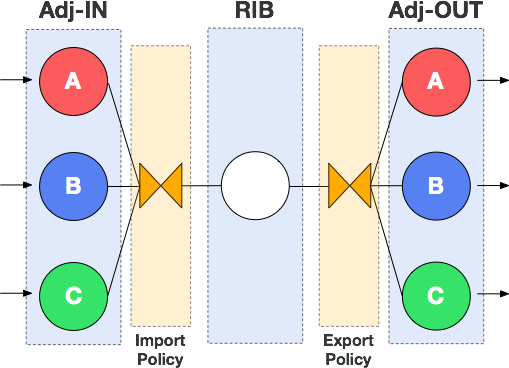
You can view the policy with the following command.
1
2
|
$ gobgp global policy import
$ gobgp global policy export
|
Route Server Policy Model
For the Route Server model, Import and Export policies are both specific to a Peer.
- The Import policy defines what routes will be imported into the master RIB.
- The Export policy defines what routes will be exported from the master RIB.
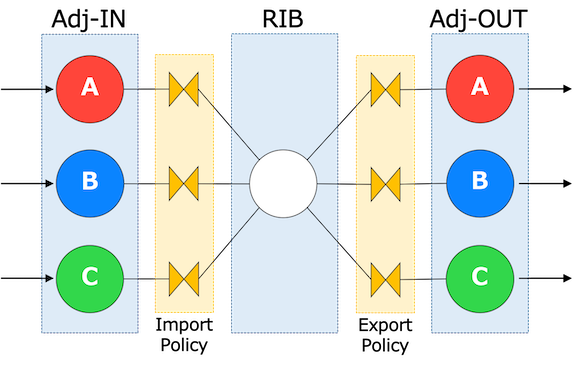
1
2
|
$ gobgp neighbor <neighbor-addr> policy import
$ gobgp neighbor <neighbor-addr> policy export
|
Policy Structure
A Policy contains multiple Statements, each with its own Condtions and Actions.

Conditions includes.
- prefix
- neighbor
- aspath
- aspath length
- community
- extended community
- rpki validation result
- route type (internal/external/local)
- large community
- afi-safi in
Actions includes.
- accept or reject
- add/replace/remove community or remove all communities
- add/subtract or replace MED value
- set next-hop (specific address/own local address/don’t modify)
- set local-pref
- prepend AS number in the AS_PATH attribute
You can view the Policy configuration with the following command.
1
2
3
4
5
6
7
8
|
$ gobgp policy
$ gobgp policy statement
$ gobgp policy prefix
$ gobgp policy neighbor
$ gobgp policy as-path
$ gobgp policy community
$ gobgp policy ext-community
$ gobgp policy large-community
|
Policy Configuration
Policy configuration is more complicated, here are the steps to configure it, you can refer to here for details.
- define defined-sets
- define prefix-sets
- define neighbor-sets
- define bgp-defined-sets
- define community-sets
- define ext-community-sets
- define as-path-setList
- define large-community-sets
- define policy-definitions
- attach policies to global rib (or neighbor local rib when neighbor is route-server-client).
Graceful Restart
1
2
3
4
5
6
7
8
9
10
|
[global.config]
as = 64512
router-id = "192.168.255.1"
[[neighbors]]
[neighbors.config]
neighbor-address = "10.0.255.1"
peer-as = 65001
[neighbors.graceful-restart.config]
enabled = true
|
BMP
GoBGP supports BGP Monitoring Protocol (RFC 7854) for real-time monitoring of the operational status of BGP sessions, including the establishment and closure of peer relationships, routing information, etc.
1
2
3
4
5
6
7
8
|
[global.config]
as = 64512
router-id = "192.168.255.1"
[[bmp-servers]]
[bmp-servers.config]
address = "127.0.0.1"
port=11019
|
Dynamic Neighbors
In a BGP network, when multiple peers change frequently, if the peers are configured statically, the peers need to be added or deleted frequently at the local end, which is a great maintenance workload. In this case, you can configure the BGP dynamic peer function to make BGP listen to BGP connection requests from the specified network segment and dynamically establish BGP peers, and add these peers to the same peer group. This reduces the workload of network maintenance by eliminating the need to add or remove BGP peers at the local end when peer changes occur.
Switches generally support the configuration of Dynamic Neighbors, such as here is the method of configuring Dynamic Neighbors for Huawei switches Dynamic Neighbors are also supported for gobgp.
As shown below, there are two main parts to configure.
- Create a peer group, describing the basic information of the peer group
- Configure the peer group to listen on the
172.40.0.0/16 network segment
1
2
3
4
5
6
7
8
9
10
11
12
13
14
15
16
17
18
19
|
[global.config]
as = 65001
router-id = "172.40.1.2"
[[peer-groups]]
[peer-groups.config]
peer-group-name = "sample-group"
peer-as = 65002
[[peer-groups.afi-safis]]
[peer-groups.afi-safis.config]
afi-safi-name = "ipv4-unicast"
[[peer-groups.afi-safis]]
[peer-groups.afi-safis.config]
afi-safi-name = "ipv4-flowspec"
[[dynamic-neighbors]]
[dynamic-neighbors.config]
prefix = "172.40.0.0/16"
peer-group = "sample-group"
|
Others
There are a lot of other features on GitHub about MRT/BMP/EVPN, so you can check out the documentation if you need to.
GoBGP Programming
Basic Server
Referring to the gobgp library documentation provided, we can implement a simple go bgp server as shown below.
1
2
3
4
5
6
7
8
9
10
11
12
13
14
15
16
17
18
19
20
21
22
23
24
25
26
27
28
29
30
31
32
33
34
35
36
37
38
39
40
41
42
43
44
45
46
47
48
49
50
51
52
53
54
55
56
57
58
59
60
61
62
63
64
65
66
67
68
69
70
71
72
73
74
75
76
77
78
79
80
81
82
83
84
85
86
87
88
89
90
91
92
93
94
95
96
97
98
99
100
101
102
103
104
105
106
107
108
109
110
111
112
113
114
115
116
117
118
119
120
121
122
123
124
|
package main
import (
"context"
"time"
"github.com/sirupsen/logrus"
apb "google.golang.org/protobuf/types/known/anypb"
api "github.com/osrg/gobgp/v3/api"
"github.com/osrg/gobgp/v3/pkg/log"
"github.com/osrg/gobgp/v3/pkg/server"
)
func main() {
log := logrus.New()
// 创建 BGP Server 实例
s := server.NewBgpServer(server.LoggerOption(&myLogger{logger: log}))
go s.Serve()
// global configuration
if err := s.StartBgp(context.Background(), &api.StartBgpRequest{
Global: &api.Global{
Asn: 65003,
RouterId: "10.0.255.254",
ListenPort: -1, // gobgp won't listen on tcp:179
},
}); err != nil {
log.Fatal(err)
}
// monitor the change of the peer state
if err := s.MonitorPeer(ctx, &api.MonitorPeerRequest{}, func(p *api.Peer) { log.Print(p) }); err != nil {
log.Fatal(err)
}
// neighbor configuration
n := &api.Peer{
Conf: &api.PeerConf{
NeighborAddress: "172.17.0.2",
PeerAsn: 65002,
},
}
if err := s.AddPeer(context.Background(), &api.AddPeerRequest{
Peer: n,
}); err != nil {
log.Fatal(err)
}
// add routes
nlri, _ := apb.New(&api.IPAddressPrefix{
Prefix: "10.0.0.0",
PrefixLen: 24,
})
a1, _ := apb.New(&api.OriginAttribute{
Origin: 0,
})
a2, _ := apb.New(&api.NextHopAttribute{
NextHop: "10.0.0.1",
})
a3, _ := apb.New(&api.AsPathAttribute{
Segments: []*api.AsSegment{
{
Type: 2,
Numbers: []uint32{6762, 39919, 65000, 35753, 65000},
},
},
})
attrs := []*apb.Any{a1, a2, a3}
_, err := s.AddPath(context.Background(), &api.AddPathRequest{
Path: &api.Path{
Family: &api.Family{Afi: api.Family_AFI_IP, Safi: api.Family_SAFI_UNICAST},
Nlri: nlri,
Pattrs: attrs,
},
})
if err != nil {
log.Fatal(err)
}
v6Family := &api.Family{
Afi: api.Family_AFI_IP6,
Safi: api.Family_SAFI_UNICAST,
}
// add v6 route
nlri, _ = apb.New(&api.IPAddressPrefix{
PrefixLen: 64,
Prefix: "2001:db8:1::",
})
v6Attrs, _ := apb.New(&api.MpReachNLRIAttribute{
Family: v6Family,
NextHops: []string{"2001:db8::1"},
Nlris: []*apb.Any{nlri},
})
c, _ := apb.New(&api.CommunitiesAttribute{
Communities: []uint32{100, 200},
})
_, err = s.AddPath(context.Background(), &api.AddPathRequest{
Path: &api.Path{
Family: v6Family,
Nlri: nlri,
Pattrs: []*apb.Any{a1, v6Attrs, c},
},
})
if err != nil {
log.Fatal(err)
}
s.ListPath(context.Background(), &api.ListPathRequest{Family: v6Family}, func(p *api.Destination) {
log.Info(p)
})
// do something useful here instead of exiting
time.Sleep(time.Minute * 3)
}
// ...
|
As you can see, the sample code is relatively simple and mainly uses the following APIs.
1
2
3
4
5
6
7
8
9
10
11
12
13
14
15
16
17
18
19
20
21
22
23
24
25
26
27
28
29
30
31
32
33
|
// 创建 BGP Server 实例
func NewBgpServer(opt ...ServerOption) *BgpServer
// 启动 BGP Server
func (s *BgpServer) Serve()
// global 配置
// BGP Server 的 AS 是 65003,RouterId 是 10.0.255.254
api.Global{
Asn: 65003,
RouterId: "10.0.255.254",
ListenPort: -1, // gobgp won't listen on tcp:179
}
// 根据传入 global 配置,开启 BGP Server 的 BGP 协商
func (s *BgpServer) StartBgp(ctx context.Context, r *api.StartBgpRequest) error
// 观察 BGP Peer 状态变化
func (s *BgpServer) MonitorPeer(ctx context.Context, r *api.MonitorPeerRequest, fn func(*api.Peer)) error
// Peer 信息
api.Peer{
Conf: &api.PeerConf{
NeighborAddress: "172.17.0.2",
PeerAsn: 65002,
},
}
// 建立 BGP Peer 连接
func (s *BgpServer) AddPeer(ctx context.Context, r *api.AddPeerRequest) error
// 传递 BGP 路由信息
func (s *BgpServer) AddPath(ctx context.Context, r *api.AddPathRequest) (*api.AddPathResponse, error)
|
Route Reflector
The api.Peer structure can be configured in more detail so that the joined BGP Peer is acting as an RR client.
1
2
3
4
5
6
7
8
9
10
|
n := &api.Peer{
Conf: &api.PeerConf{
NeighborAddress: "172.25.0.6",
PeerAsn: 1001,
},
RouteReflector: &api.RouteReflector{
RouteReflectorClient: true,
RouteReflectorClusterId: "172.25.0.7",
}
}
|
BMP
Here is a list of several common BMP messages.
1
2
3
4
5
6
7
8
9
10
11
12
13
14
15
16
17
18
19
20
21
22
23
24
25
26
|
type BMPMessage struct {
Header BMPHeader
PeerHeader BMPPeerHeader
Body BMPBody
}
type BMPRouteMonitoring struct {
BGPUpdate *bgp.BGPMessage
BGPUpdatePayload []byte
}
type BMPPeerDownNotification struct {
Reason uint8
BGPNotification *bgp.BGPMessage
Data []byte
}
type BMPPeerUpNotification struct {
LocalAddress net.IP
LocalPort uint16
RemotePort uint16
SentOpenMsg *bgp.BGPMessage
ReceivedOpenMsg *bgp.BGPMessage
}
// ...
|









